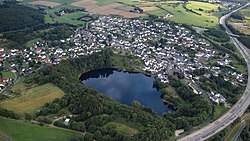|
Ulmen
Ulmen is a town in the Cochem-Zell district in Rhineland-Palatinate, Germany. It is the seat of the like-named Verbandsgemeinde – a kind of collective municipality – to which it also belongs. GeographyLocationThe town lies in the Eifel some 11 km northwest of Cochem. Constituent communitiesTo Ulmen belong the outlying centres – Stadtteile – of Meiserich, Vorpochten and Furth. GeologyThe Ulmener Maar, only about 11,000 years old, is not only a maar but also Continental Europe's newest volcano north of the Alps. It is 37 m deep. Volcanic activity can be observed at depths of more than 4 m in the form of rising gas bubbles. The Ulmener Maar has no natural water inflow or outflow. The two tunnels that hold the water at a constant level today were dug in the 19th century. Another maar in town is the 118,000-year-old Jungferweiher, which is considerably bigger than the Ulmener Maar. Formerly used as a fishpond for the lords of the castle, it dried up over the centuries until in the 1930s, it had become a peat bog. In 1942, however, the maar was flooded once again to regulate the water level in the nearby maar. HistoryIn 1074, Ulmen had its first documentary mention, though Merovingian graves south of the castle bear witness to earlier habitation within town limits. There have also been suspected Roman finds, but these have not yet been verified. Sir Heinrich von Ulmen, a knight, went on the Fourth Crusade to Constantinople, whence he brought valuable treasures back, among others the famous Limburger Staurothek ("Limburg Reliquary of the True Cross"), which can still be seen in the cathedral in Limburg an der Lahn. His successors were in the 15th century subject to the Trier Archiepiscopal Foundation's public peace (Landfrieden). The "Sun King" Louis XIV of France conquered Ulmen twice and burnt it down. Both times, the castle and the town were built up again. Beginning in 1794, Ulmen lay under French rule. In 1815 it was assigned to the Kingdom of Prussia at the Congress of Vienna. Since 1946, it has been part of the then newly founded state of Rhineland-Palatinate. Many old buildings bear witness even today to Ulmen's historical past. In the 19th century, when buildings confiscated by Napoleon were transferred to Prussian ownership, a Cochem townsman bought the castle and used it as a quarry. When Ulmen all but burnt down in a fire in 1831, the houses were rebuilt using stones from the castle. Since then, it has been a ruin. In the forest that abuts the town is an old spring near which some Roman and Celtic figures were found. This spring is called Dietzjes Bärechje, a reference to children; for centuries, women prayed here for a good birth and healthy children. In 1376, Ulmen was granted town rights by Emperor Karl IV.[3] These rights were, however, lost as the Prussians took over the Rhineland in 1815. By decision of the Rhineland-Palatinate Cabinet on 1 September 2009, Ulmen was once again allowed to bear the designation Stadt ("town") with effect from 2 October 2009.[4] PoliticsTown councilThe council is made up of 20 council members, who were elected by proportional representation at the municipal election held on 7 June 2009, and the honorary mayor as chairman. The municipal election held on 7 June 2009 yielded the following results:[5]
MayorUlmen's mayor is Thomas Kerpen (CDU).[1] Coat of armsThe town's arms might be described thus: Per pale Or issuant from base a poleaxe sable and gules issuant from base a gatehouse with flanking towers embattled, the dexter taller than the sinister argent, on a chief of the fourth eight lozenges conjoined in fess throughout of the third. Town partnershipsUlmen fosters partnerships with the following places: In 1994, Ulmen and Lormes initiated the first contacts for a partnership. Both places contain an element meaning "elm" in their respective languages (Ulme, pl. Ulmen in German; orme in French). The partnership documents were signed in Lormes on 23 June 1996. Culture and sightseeingMuseums
BuildingsThe following are listed buildings or sites in Rhineland-Palatinate's Directory of Cultural Monuments: Ulmen (main centre)
Furth
Meiserich
Castle Ulmen, nowadays only a ruin, was built sometime about the year 1000, apparently on the remnants of a Roman building, although this has never been established through archaeological findings. Its current state is marked by somewhat less than successful restoration measures which have hidden much of the building's original substance. Saint Matthias's Parish Church was built in Romanesque Revival-Gothic Revival style. Music
SportThe Sportverein Fortuna Ulmen e.V. (sport club) was founded on 21 September 1921 and offers active sport in the departments of aerobics, men's and women's artistic gymnastics, football, "seniors'" football, track and field, skipping, table tennis, gymnastics and volleyball. Regular events
Sightseeing gallery
Economy and infrastructureEducation
Bundeswehr presenceThe Schule für Diensthundewesen der Bundeswehr – a training school for dogs used in the German military – was moved in April 2005 from Koblenz-Bubenheim to the former munitions depot in the Hochpochtener Wald (forest) near Ulmen. Both the dogs themselves and their trainers are trained here. In the framework of the festivities for the school's 50th anniversary on 8 August 2008, the until now nameless installation in the Hochpochtener Wald was given the name Gräfin von Maltzan-Kaserne (Kaserne means "barracks"), after the veterinarian Maria von Maltzan, who was a member of the German Resistance in the time of the Third Reich; she helped those who were subject to Adolf Hitler's repression and persecution, even hiding her future husband, a Jew, inside a couch.[7] The then Ortsgemeinde of Ulmen took over sponsorship of this Bundeswehr facility, which was unique in Germany, on 30 January 2009. References
External linksWikimedia Commons has media related to Ulmen (Eifel).
|
||||||||||||||||||||||||||||||||||||||||||||||||||||||||||||||||||||









